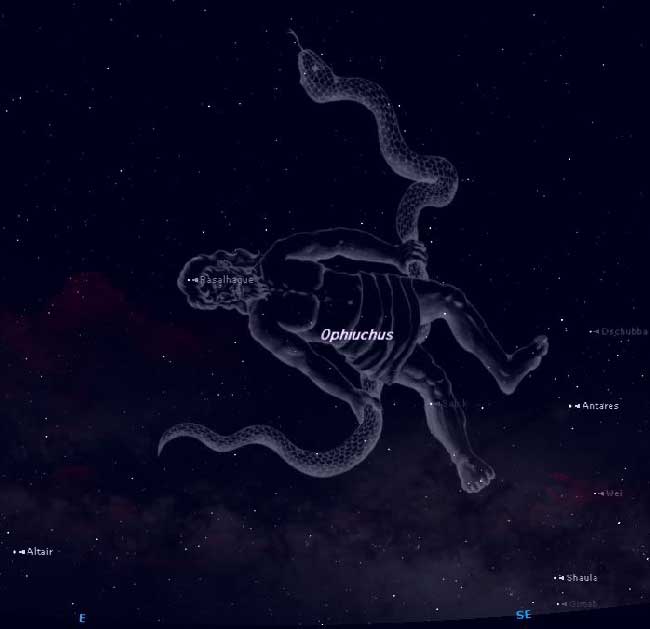
During the late evening hours we can look high toward the southeast and see the "celestial medicine man" Ophiuchus, the Serpent Bearer, a star pattern that is teamed with the constellation Serpens. Serpens, the Snake is the only constellation that's cut in two.
The head of the Serpent lies west of the giant constellation Ophiuchus and is known as Serpens Caput; while to the east of Ophiuchus lies smaller Serpens Cauda, the tail.
Recognized by Hippocrates
The Hippocratic Oath, named after the ancient Greek physician Hippocrates (460-377 B.C.) – often regarded as the Father of Medicine – begins, "I swear by Apollo Physician and Aesculapius and Hygeia and Panacea and all the gods and goddesses, making them my witness, that I will fulfill according to my ability and judgment this oath and covenant."
The constellation's odd name of Ophiuchus derives from the Greek roots ophis (serpent) and cheiro-o (to handle). As for Hygeia and Panacea, they were Aesculapius's daughters. Although not represented in the sky, like their father, both have long been patron saints to modern-day physicians.
King James I of England, who reigned in the 1600's, referred to Ophiuchus as "a mediciner after made a god," because the Serpent Bearer was often identified with Aesculapius, who, in Greek mythology, was originally a mortal physician who never lost a patient by death. This alarmed Hades, god of the dead, who prevailed on his brother, Zeus, to liquidate Aesculapius. In recognition of his merits, however, Aesculapius was put into the sky as a constellation. The association with a serpent may have come from the belief that, by shedding its skin, it is rejuvenated.
And to this day, the symbol of the medical profession is the caduceus insignia of our Army's Medical Corps which is a winged staff with serpents twined around it.
Get the Space.com Newsletter
Breaking space news, the latest updates on rocket launches, skywatching events and more!
Unlucky zodiacal member?
Interestingly, during late autumn the sun, moving along the ecliptic, will be in Ophiuchus for 19 days. It enters Scorpius on November 23, leaves a week later for Ophiuchus on November 30 and enters Sagittarius on December 18. Thus, the sun is in Ophiuchus more than twice as long as in Scorpius, an "official" zodiacal constellation.
Ophiuchus on the other hand is not recognized by astrologers as one of the traditional houses of the sun, perhaps because it would be the "13th sign" (an unlucky number?).
The runaway star
Ophiuchus also has the distinction of containing the star with the largest known apparent motion ("proper motion") in our sky. It is Barnard's Star, a 9.5-magnitude red dwarf that is named after Edward Emerson Barnard (1857-1923), one of those legendary telescopic observers of an era long gone.
It was Barnard, who in 1916 spotted its rapid motion during a comparison of photographic plates of the Milky Way made in 1894 and 1916. Sometimes called Barnard's "Runaway Star," it has a mass computed to be just 16 percent that of the sun and a luminosity only 1/2500 that of the sun. It's the next closest star to us after the Alpha Centauri system, at 5.9 light years; its actual velocity is about 103 miles per second and its proximity plus high space velocity combine to give it a proper motion of 10.31 seconds of arc each year.
Put into layman's terms, from our Earthly vantage point, this carries it across the sky at roughly the apparent width of the full moon (about a half degree) in less than 180 years.
Joe Rao serves as an instructor and guest lecturer at New York's Hayden Planetarium. He writes about astronomy for The New York Times and other publications, and he is also an on-camera meteorologist for News 12 Westchester, New York
Join our Space Forums to keep talking space on the latest missions, night sky and more! And if you have a news tip, correction or comment, let us know at: community@space.com.

Joe Rao is Space.com's skywatching columnist, as well as a veteran meteorologist and eclipse chaser who also serves as an instructor and guest lecturer at New York's Hayden Planetarium. He writes about astronomy for Natural History magazine, Sky & Telescope and other publications. Joe is an 8-time Emmy-nominated meteorologist who served the Putnam Valley region of New York for over 21 years. You can find him on Twitter and YouTube tracking lunar and solar eclipses, meteor showers and more. To find out Joe's latest project, visit him on Twitter.









